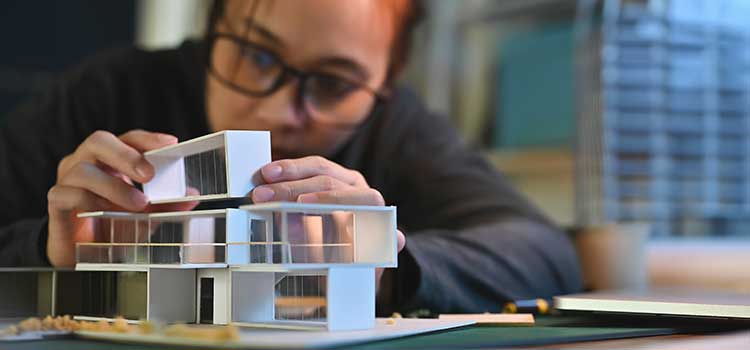Architect Advice on Maximizing Small Urban Spaces
Wiki Article
Understanding the Diverse Occupation Paths Available for Aspiring Architect
As a hopeful Architect, you have a globe of occupation paths waiting for you. Each path provides unique obstacles and chances to use your creativity and technical expertise. Whether you're attracted to conventional design or the subtleties of lasting style, there's a niche that lines up with your rate of interests. Understanding these diverse options can shape your professional trip, yet which direction will you choose to check out first?Typical Design: Creating Structures and buildings
Conventional style concentrates on creating buildings and frameworks that mix performance with visual charm. Your layouts can show social heritage, showcasing local practices while meeting modern needs.You'll establish skills in preparing, model-making, and website evaluation, enabling you to imagine and connect your ideas properly. Engaging with customers, you'll require to comprehend their vision and convert it into feasible layouts.
In addition, building codes and sustainability techniques are important in your work, ensuring your frameworks are secure and eco-friendly. As you expand in your profession, you'll discover possibilities in residential, industrial, or also remediation tasks, each offering unique challenges. Accepting traditional style leads the means for a satisfying profession that pays homage to the past while forming the future.
Urban Preparation: Forming Areas and Public Spaces
As a hopeful Architect, you can play a crucial role as an urban coordinator, transforming just how areas connect and function. By using neighborhood engagement approaches, you'll guarantee that locals have a voice fit their environment. And also, integrating lasting layout concepts will help develop areas that not just meet today's demands but additionally secure the future.Role of Urban Planners
While lots of might consider architects as the sole enthusiasts behind buildings, metropolitan coordinators play a necessary function fit the wider landscape of communities and public areas. They evaluate land usage, zoning regulations, and area requires to produce sustainable environments that improve lifestyle. By teaming up with different stakeholders, you'll help make parks, transport systems, and houses that advertise social interaction and access. Urban coordinators additionally focus on environmental factors to consider, making certain that growths incorporate environment-friendly areas and assistance biodiversity. Your knowledge in spatial style and neighborhood dynamics allows you to envision future development while maintaining social heritage. In this crucial function, you'll directly affect how people experience their environments, making every project an opportunity for positive adjustment.Community Involvement Methods
Reliable area involvement methods are crucial for urban coordinators to ensure that the voices of homeowners are listened to and valued in the preparation procedure. To promote meaningful discussion, you should focus on open online forums and workshops where neighborhood members can reveal their ideas and concerns. By actively including and listening feedback, you'll create spaces that reflect the community's needs, ultimately leading to even more sustainable and effective urban atmospheres.Sustainable Style Concepts
When developing metropolitan rooms, incorporating lasting style principles is critical for developing atmospheres that flourish both ecologically and socially. You ought to start by concentrating on power performance, utilizing materials that minimize waste and advertise recycling. Consider incorporating eco-friendly areas, like parks and gardens, to improve biodiversity and enhance air top quality. Advertising walkability and public transportation can lessen reliance on cars, promoting a much healthier neighborhood.Designing with water preservation in mind is additionally essential-- consider rain gardens and permeable surface areas to manage stormwater. Involving area members during the planning process guarantees that the areas you create meet their needs and encourage social communication. By accepting these principles, you'll add to dynamic, lasting urban landscapes that profit everyone.

Landscape Style: Creating Sustainable Outdoor Settings
As you discover landscape architecture, you'll discover necessary design concepts that develop functional and gorgeous outside spaces. Lasting practices play an essential duty in guaranteeing these settings thrive while minimizing ecological influence. Plus, you'll find a range of career possibilities that enable you to make a real difference in how individuals connect with nature.Style Principles in Landscape
Understanding style principles in landscape design is necessary for developing sustainable exterior environments that harmonize with nature. You'll require to ponder elements like equilibrium, scale, and percentage to assure your designs really feel natural and inviting. Additionally, pay attention to seasonal changes, designing with products that complement the surroundings year-round.Lasting Practices Overview
Lasting techniques in landscape style not only concentrate on looks but likewise focus on eco-friendly wellness and source preservation. You can create spaces that promote soil health and wellness, such as utilizing organic materials and practicing permaculture concepts. Inevitably, these practices ensure your styles benefit both individuals and the atmosphere for years to come.Profession Opportunities Expedition
With a solid foundation in lasting techniques, landscape style provides a variety of career courses that allow you to get more info make a significant effect on the atmosphere. You can function as a landscape designer, developing visually pleasing and useful exterior spaces, or focus on ecological reconstruction, aiding to revive damaged environments. Urban planners commonly collaborate with landscape engineers to produce environment-friendly spaces in city setups, boosting city livability. If you're enthusiastic about education and learning, consider ending up being a landscape architecture educator, motivating future generations. In addition, you could function with nonprofits concentrated on environmental sustainability or take part in study to introduce brand-new techniques. Each path not only forms beautiful atmospheres yet also cultivates a healthier earth for future generations.Lasting Style: Focusing on Eco-Friendly Practices
As you discover your occupation in architecture, welcoming environment-friendly methods can establish you apart in an affordable field. Lasting design concentrates on producing structures that reduce environmental influence while improving resident well-being. By including eco-friendly materials, energy-efficient systems, and lasting structure techniques, you'll contribute to a greener future.Start by gaining expertise of eco-friendly accreditations like LEED or BREEAM, which can bolster your qualifications. Consider exactly how natural light, air flow, and thermal efficiency can maximize style. Work together with designers and environmental professionals to introduce remedies that lower waste and save sources.
Don't forget the importance of area participation-- engaging neighborhood stakeholders can inspire styles that harmonize with the atmosphere. As customers increasingly focus on sustainability, your expertise in green practices will not only attract jobs however likewise accomplish your interest for responsible design. Accept this crucial element of the occupation, and enjoy your job flourish.
Historic Conservation: Safeguarding and Recovering Cultural Heritage
While you commence on your building trip, think about the vital duty of historical preservation in preserving our cultural heritage. This field focuses on the protection and restoration click here of considerable buildings, websites, and frameworks that inform the stories of our past. By participating in historical conservation, you'll help guard the building tradition that forms community identity.As a historic conservation Architect, you'll examine historical significance and analyze the problem of structures. You'll work closely with historians and guardians to ensure genuine repair strategies are used. This profession path enables you to blend creativity with study, allowing you to make solutions that value initial materials and craftsmanship.
Your work not just adds to sustainability by reusing existing structures however also promotes a sense of pride within areas. Welcoming this course will aid you come to be a guardian of history, preserving the stories and aesthetic appeals that enrich our lives.
Inside Design: Enhancing Indoor Spaces
Historic preservation and indoor architecture both share a dedication to enhancing the developed atmosphere, however they concentrate on various aspects. While historic conservation stresses maintaining a structure's historical and cultural worth, indoor architecture nos in on maximizing indoor areas for functionality and appearances.As a hopeful Architect, you'll locate that indoor architecture enables you to mix imagination with technological abilities. You'll develop rooms that not only look good however additionally advertise comfort and efficiency. This area entails understanding exactly how light, shade, and products communicate within an area, influencing mood and usability.
You'll service numerous tasks, from domestic homes to commercial offices, ensuring that each setting fulfills the needs of its occupants. By focusing on customer experience, you can transform interiors into inspiring and useful areas, making a considerable influence on how people interact with their environments. Embrace the possibility to boost indoor atmospheres and form the way individuals function and live.
Industrial Style: Combining Capability With Aesthetic Appeals
Industrial layout plays an essential role in developing products that seamlessly blend looks with functionality, guaranteeing that what you use day-to-day is not only visually appealing but additionally functional. As an aspiring Architect, you might immerse on your own in this area, focusing on designing every little thing from furniture to consumer electronic devices. Your work entails comprehending user demands, products, and manufacturing procedures, enabling you to develop ingenious services that boost daily experiences.In industrial style, you'll usually collaborate with engineers, marketing experts, and manufacturers, guaranteeing that your layouts are not only gorgeous however additionally possible. This profession course offers a dynamic setting where imagination satisfies usefulness, making it a fulfilling choice for click here architects interested in shaping the products of tomorrow.
Frequently Asked Questions
What Educational Credentials Do I Need to End Up Being a Designer?
To come to be an engineer, you'll require a professional degree in architecture, usually a Bachelor's or Master's. Furthermore, you'll need to finish a teaching fellowship and pass the Architect Enrollment Exam to exercise legally.Are There Accreditation Demands for Various Building Occupation Paths?
Yes, there're certification requirements for various architectural paths. Architect. You'll require to pass examinations, complete teaching fellowships, and occasionally go after specialized training, depending on your picked emphasis, like landscape architecture, city layout, or historical conservationWhat Software Program Skills Are Essential for Designers Today?

Exactly How Can I Gain Practical Experience While Examining Architecture?
You can gain sensible experience by interning at architectural companies, getting involved in design competitions, volunteering for neighborhood projects, or teaming up with classmates on real-world assignments. These possibilities improve your skills and construct important connections in the sector.What Task Opportunities Exist Outside Typical Design Firms?
You can explore numerous task opportunities outside typical design firms, like urban planning, interior decoration, landscape style, building and construction monitoring, realty advancement, and even functions in sustainability consulting. Each offers distinct challenges and rewards.Whether you're attracted to typical style or the nuances of lasting design, there's a niche that aligns with your passions.When making metropolitan spaces, including sustainable design concepts is vital for creating environments that thrive both ecologically and socially.As you discover landscape design, you'll uncover important layout principles that develop attractive and useful exterior rooms.Understanding style concepts in landscape style is important for producing lasting outdoor environments that balance with nature.In commercial design, you'll commonly collaborate with manufacturers, online marketers, and designers, ensuring that your designs are not only beautiful however additionally feasible.
Report this wiki page